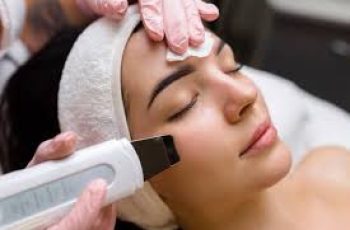
“Micro-Coring” Is a Minimally Invasive Alternative to a Facelift—Does It Work?
When it comes to visible skin aging, there are a plethora of potions and products to address almost every concern. Fine lines, wrinkles, pigmentation, and crepeyness all seem to have met their match, but the effects of Earth’s gravitational pull are possibly the most difficult to address. Sagging skin can happen for various reasons like aging or weight loss, and until recently there was only one truly effective treatment: a facelift. If the mere mention of the mother of all invasive treatments sent a shiver up your spine, we’ve got good news. Micro-coring is a minimally invasive treatment that achieves scarless skin removal and targets moderate to severe skin laxity and wrinkles. But what is it exactly, and is it a suitable alternative? Ahead, two plastic surgeons and a dermatologist break down the ins and outs of micro-coring, and share whether they recommend the treatment.
What Is Micro-Coring?
Micro-coring technology (MCT) is a minimally invasive treatment that targets moderate to severe skin laxity and wrinkles using hollow coring needles that, when inserted into skin, excise cores the size of the needle’s inner diameter. Compared with microneedling (which punctures the skin without removing tissue), the DMCD needle removes full-thickness cores of skin, resulting in tighter skin and less wrinkles.1
For patients who have longed for a solution to sagging facial skin and wrinkles without going under the knife, micro-coring is the new sparkly toy on the shelf. “Micro-coring is a relatively new treatment for loose skin,” notes board-certified plastic surgeon Darren M. Smith, MD, FACS. “The technology is based on the fact that one of the ways a wound heals is contraction—if there is a hole in the skin, the body literally shrinks the hole. Micro-coring devices, like Ellacor, function like a cookie cutter to create tiny holes in the skin. Four to eight percent of the skin in the treatment area is removed, making the skin contract, [forming] new collagen and elastin, and [tightening] skin in the area. The key to success here is the fact that the holes created by the micro-coring device are small enough not to leave a scar behind.”
Benefits of Micro-Coring
The benefits of micro-coring are rather straightforward, as the technology is designed specifically for skin tightening. The main effects are as follows:
Tightens loose skin
Boosts collagen and elastin production
Reduces fine lines and wrinkles
“Micro-coring promotes skin tightening by removing a small percentage of skin and triggering the production of collagen,” says double-board-certified dermatologist Brendan Camp, MD. “Skin tightening can improve the appearance of loose or lax skin, a common concern among those with mature skin. It can also soften the appearance of lines or wrinkles that appear as the result of normal aging or sun damage.”
How to Prepare for Micro-Coring
Step one in preparing for micro-coring is checking in with your dermatologist to find out your skin’s specific needs. Still, there are a few general tips you’ll likely be advised to follow ahead of your treatment.
Avoid blood thinners: “It’s a good idea to avoid blood thinners [unless medically necessary] prior to the procedure to reduce bruising,” Smith notes.
Minimize other treatments: Similar to any procedure, “you should not have procedures or use at-home treatments that might irritate the skin in the planned treatment area,” Smith says. Ask your plastic surgeon or dermatologist about more specific advice as to what you should avoid leading up to your treatment.
Avoid tanning: “Refrain from self-tanning and tanning beds,” Smith tells us. This further helps to minimize irritation or disruption that could conflict with your micro-coring procedure.
Don’t forget sunscreen: Last but not least, wear SPF daily to keep your skin protected. Of course, you should even do this if you aren’t preparing to get a treatment, as there’s never a good time for sun damage.
Beyond this, your dermatologist or plastic surgeon will be able to tell you how to best prepare, so their advice always takes priority. “Other specific instructions will depend on your skin type and the condition of your skin,” Smith says.
What to Expect During Micro-Coring
The experts say not to expect too much of anything during micro-coring, as the treatment is fairly simple. It typically takes about an hour, and thanks to local anesthesia, pain and discomfort are minimal during the procedure. “Any discomfort that develops afterward can often be treated with cold compresses and over-the-counter pain medication,” Camp adds. You may also experience redness.
Micro-Coring vs. Microneedling
Unsurprisingly, it’s easy to mix up micro-coring and microneedling, as both the names and tools used are similar. Like micro-coring, microneedling uses fine needles to puncture the skin with the goal of boosting collagen and reducing fine lines and wrinkles. Microneedling can also improve skin texture, and it’s often recommended for acne scar treatment. However, the technicalities behind microneedling are different.
“No skin is removed in traditional microneedling treatments,” Camp tells us. “Superficial injuries are created in the dermal tissue during a microneedling treatment, which triggers the healing properties of skin to encourage production of new collagen. Radiofrequency microneedling emits heat to ablate a portion of the dermis [and] create a more robust response. Fractional CO2 laser treatment uses thermal energy to ablate a portion of the epidermis and dermis, tightening skin and stimulating collagen production to improve the appearance of sun damage, fine lines, and wrinkles.”
Micro-Coring vs. Other Tightening Treatments
Micro-coring is by no means the only minimally invasive alternative to a face life. Ultrasound technology, like Ultherapy, and radiofrequency treatments also claim skin-tightening benefits. “RF [radiofrequency] and US [ultrasound] treatments, plus thread lifts, all work to help tighten the skin and decrease sagging and signs of aging. One may choose micro-coring over the other options because it is minimally-invasive (vs thread lifts) and does not use thermal or ultrasonic energy to yield results,” explains double-board-certified plastic and reconstructive surgeon Jaimie DeRosa, MD. “Instead, it punches out thousands (think 10-12K) of microscopic (less than 500 micrometers) cores of skin, removing typically 4 to up to 8% of the treated skin, stimulating new collagen growth. The main reason I would choose micro-coring over other similar treatments is that it does not involve thermal (heat) injury, which can be an issue for those with darker skin types and those who tend to get dark scarring (hyperpigmentation).”
Can You Try Micro-Coring at Home?
While the answer is not technically a firm no, experts feel strongly that it’s best to get micro-coring in-office from a licensed professional. “While regulatory requirements will vary on a state-by-state basis, I would feel most comfortable with a treatment like this being administered by a physician,” Smith emphasizes. “Ideally, someone with in-depth knowledge of facial anatomy and the physiology of aging is best suited to perform these procedures, and this would be someone like a plastic surgeon, a dermatologist, or a facial plastic surgeon. These procedures should be performed in a medical office in a sterile environment.”
Just as important as working with a professional during your treatment, the experts also note that you should consult your doctor post-treatment for all care or any issues that arise for the safest and best results.
Potential Side Effects
While micro-coring is generally considered safe, it does involve needles puncturing the skin, which inherently comes with a risk of side effects. “There is a risk of scarring, but the pieces of skin removed in micro-coring are so small that scarring is generally not noticeable,” Camp says. “Any procedure involving the skin can potentially put the skin at risk of discoloration, pain, bleeding, and infection. Because of the risk of discoloration, micro-coring is currently marketed for skin types I-IV.” The potential risks here mainly emphasize why it’s so important to receive this treatment from a trusted professional, and if you have a skin type that micro-coring isn’t currently marketed for, we recommend asking your dermatologist or plastic surgeon about your best pathways to achieving similar results.
Cost
Micro-coring typically requires a series of three treatments, and each one is an investment. Currently, single micro-coring treatments typically cost between $2500 and $3500. As a series of three, the total treatment can run you over $10K, so keep that in mind when considering your options and feel free to ask your provider for recommended alternatives if budget is a concern.
Results
According to DeRosa, patients can expect bruising, swelling, and redness in the treatment area for three to four days. “It will also take about a week for the treatment-induced holes to close before any makeup should be used,” she continues. “The results of micro-coring are dependent on multiple factors, including age, degree of aging prior to treatment, core depth, and number of treatments.” Typically, three treatments are performed four to six weeks apart and DeRosa explains that it can typically take four to six months to see results.
“Just like any other anti-aging treatment, if you want to keep holding back the effects of aging on your skin, you’ll likely need to repeat anti-aging treatments such as micro-coring,” adds DeRosa “The frequency can vary, but I tell my patients who have skin tightening procedures similar to micro-coring to expect about a 3-to-5-year timeframe for repeat treatments. Now, this is super variable and dependent of a variety of factors, including what other anti-aging treatments you pursue in-between this type of procedure, your home skin-care routine, etc.”
Aftercare
Since micro-coring uses needles to remove excess skin, you’ll need to take a few precautions afterwards to ensure it heals properly. Your provider will be able to provide the best aftercare plan, but a few top tips are as follows:
Be patient: First and foremost, our experts recommend giving yourself up to a week of recovery time. “While the downtime may only be three days of redness, it is a good idea to budget in a week of recovery,” Camp says.
Avoid unnecessary irritation: Your skin will be more sensitive than usual while healing, so try not to expose it to anything that disrupts the process. “Plan to avoid the sun and the use of makeup for at least a week after treatment,” Camp advises.
Practice a gentle skincare routine: Rather than using your normal skincare products, you’ll want to choose gentle options that support the healing process and minimize potential irritation. “General aftercare instructions include using a gentle cleanser and an occlusive healing ointment, such as Aquaphor,” Camp tells us. “In general, you’ll want to avoid parabens and fragrances,” adds DeRosa. “Sometimes we also recommend using products that will enhance healing (such as a growth serum) or hydration, such as a hyaluronic acid. Since this treatment is more invasive as compared to microneedling, it’s super important to follow your provider’s post-treatment instructions.”
During the micro-coring recovery period, you may experience swelling, redness, and slight discomfort, with other rarer side effects also possible. If you notice anything of concern, bring it to your doctor’s attention right away so they can help you resolve it and minimize any complications.


